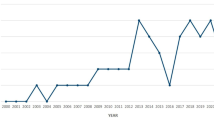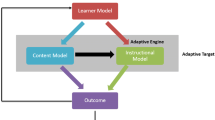Abstract
Sophisticated educational technologies are evolving rapidly, and online courses are becoming more easily available, generating interest in innovating lightweight data-driven adaptive approaches that foster responsive teaching and improving the overall learning experience. However, in most existing adaptive educational systems, the black-box modeling of learner and instructional models based on the views of a few designers or experts tended to drive the adaptation of learning content. However, different sources of uncertainty could affect these views, including how accurately the proposed adaptive educational methods actually assess student responses and the corresponding uncertainties associated with how students receive and comprehend the resulting instruction. E-learning environments contain high levels of linguistic uncertainties, whereby students can interpret and act on the same terms, words, or methods (e.g., course difficulty, length of study time, or preferred learning style) in various ways according to varying levels of motivation, pre-knowledge, cognition, and future plans. Thus, one adaptive instructional model does not fit the needs of all students. Basing the instruction model on determining learners’ interactions within the learning environment in interpretable and easily read white-box models is crucial for adapting the model to students’ needs and understanding how learning is realized. This paper presents a new zSlices-based type-2 fuzzy-logic-based system that can learn students’ preferred knowledge delivery needs based on their characteristics and current levels of knowledge to generate an adaptive learning environment. We have evaluated the proposed system’s efficiency through various large-scale, real-world experiments involving 1871 students from King Abdulaziz University. These experiments demonstrate the proposed zSlices type-2 fuzzy-logic-based system’s capability for handling linguistic uncertainties to produce better performance, particularly in terms of enhanced student performance and improved success rates compared with interval type-2 fuzzy logic, type-1 fuzzy systems, adaptive, instructor-led systems, and non-adaptive systems.



















Similar content being viewed by others
References
Ahmad A, Basir O, Hassanein K (2004) Adaptive user interfaces for intelligent e-learning: issues and trends. In: Proceedings of the fourth international conference on electronic business (ICEB2004), Xiyuan Hotel, Beijing, China, pp. 925-934
Allen IE, Seaman J (2008) Staying the course: online education in the United States. Sloan Consortium, Sloan-C, Needham
Almohammadi K, Hagras H (2013) An adaptive fuzzy logic based system for improved knowledge delivery within intelligent E-Learning platforms. In: Proceedings of the 2013 IEEE international conference on fuzzy systems, pp 1–8
Almohammadi K, Hagras H (2013) An interval type-2 fuzzy logic based system for customised knowledge delivery within pervasive e-learning platforms. In: Proceedings of the 2013 IEEE international conference on systems, man, and cybernetics, 2013, pp 2872–2879
Almohammadi K, Hagras H, Yao B, Alzahrani A, Alghazzawi D, Aldabbagh G (2015) A type-2 fuzzy logic recommendation system for adaptive teaching. Soft Comput. doi:10.1007/s00500-015-1826-y
Almohammadi K, Yao B, Hagras H (2014) An interval type-2 fuzzy logic based system with user engagement feedback for customized knowledge delivery within intelligent E-learning platforms. In: Proceedings of the 2014 IEEE international conference on fuzzy systems, 2014, pp 808–817
Ambient Insight Research (2009) US self-paced e-learning market. Ambient Insight Research, Monroe
Bai S-M, Chen S-M (2008) Evaluating students’ learning achievement using fuzzy membership functions and fuzzy rules. Expert Syst Appl 34(1):399–410
Bilgin A, Dooley J, Whittington L, Hagras H, Henson M, Wagner C, Malibari A, Al-Ghamdi A, Al-haddad M, Al-Ghazzawi D (2012) Dynamic profile-selection for zSlices based type-2 fuzzy agents controlling multi-user ambient intelligent environments. In: Proceedings of the 2012 IEEE international conference on fuzzy systems, Brisbane
Bloom B (1984) The 2 sigma problem: the search for methods of group instruction as effective as one-to-one tutoring. Educ Res 13:4–16
Cha HJ, Kim YS, Park SH, Yoon TB, Jung YM, Lee J-H (2006) Learning styles diagnosis based on user interface behaviors for the customization of learning interfaces in an intelligent tutoring system. In: Ikeda M, Ashley KD, Chan T-W (eds) Intelligent tutoring systems, vol 4053. Springer, Berlin, pp 513–524
Chen S-M, Li T-S (2013) Evaluating students’ answerscripts based on interval-valued intuitionistic fuzzy sets. Inf Sci 235:308–322
Chrysafiadi K, Virvou M (2015) Fuzzy logic for adaptive instruction in an e-learning environment for computer programming. IEEE Trans Fuzzy Syst 23(1):164–177
Ciloglugil B (2012) Inceoglu M user modeling for adaptive e-learning systems. Comput Sci Appl 7335:5561
Essalmi F, Ayed LJB, Kinshuk M Jemni, Graf S (2010) A fully personalization strategy of E-learning scenarios. Comput Hum Behav 26(4):581–591
Frias-Martinez E, Magoulas G, Chen S, Macredie R (2004) Recent soft computing approaches to user modeling in adaptive hypermedia. In: Yz X (ed) Adaptive hypermedia and adaptive web-based systems. Springer, Berlin, pp 31–55
Gertner AS, VanLehn K (2000) Andes: a coached problem solving environment for physics. In: Gauthier G, Frasson C, VanLehn K (eds) Intelligent tutoring systems, vol 1839. Springer, Berlin, pp 133–142
Gutierrez-Santos S, Mayor-Berzal J, Fernandez-Panadero C, Kloos CR (2010) Authoring of probabilistic sequencing in adaptive hypermedia with Bayesian networks. J Univers Comput Sci 16(19):2801–2820
Hagras H (2004) A hierarchical type-2 fuzzy logic control architecture for autonomous mobile robots. IEEE Trans Fuzzy Syst 12(4):524–539
Hagras H, Doctor F, Lopez A, Callaghan V (2007) An incremental adaptive life long learning approach for type-2 fuzzy embedded agents in ambient intelligent environments. IEEE Trans Fuzzy Syst 15(1):41–55
Hagras H (2007) Embedding computational intelligence in pervasive spaces. IEEE Pervasive Comput 6(3):85–89
Hagras H, Packham I, Vanderstockt Y, Mcnulty N, Vadher A, Doctor F (2008) An intelligent agent based approach for energy management in commercial buildings. In: Proceedings of the 2008 IEEE international conference on fuzzy systems, Hong Kong, pp156–162
Hsieh T-C, Wang T-I, Su C-Y, Lee M-C (2012) A fuzzy logic-based personalized learning system for supporting adaptive english learning. J Educ Technol Soc 15(1):273–288
Huang M, Huang H, Chen M (2007) Constructing a personalized e-learning system based on genetic algorithm and case-based reasoning approach. Expert Syst Appl 33(3):551–564
Idris N, Yusof N, Saad P (2009) Adaptive course sequencing for personalization of learning path using neural network. Int J Adv Soft Comput Appl 1:49–61
James LA (2012) Evaluation of an adaptive learning technology as a predictor of student performance in undergraduate biology (Master’s thesis). Appalachian State University, North Carolina, USA
Jameson A (1996) Numerical uncertainty management in user and student modeling: an overview of systems and issues. User Model User Adapt Interact 5(3–4):103–251
Kavčič A (2004) Fuzzy user modeling for adaptation in educational hypermedia. IEEE Trans Syst Man Cybern C Appl Rev 34(4):439–449
Kavčič A, Pedraza-Jiménez R, Molina-Bulla H, Valverde-Albacete FJ, Cid-Sueiro J, Navia-Vázquez A (2003) Student modelling based on fuzzy inference mechanisms. In: Proceedings of the IEEE region 8 EUROCON 2003: computer as a tool, Ljubljana, Slovenia
Kidd T (2010) Online education and adult learning. Hershey, New York
Liu F, Mendel J (2007) An interval approach to fuzzistics for interval type-2 fuzzy sets. In: Proceedings of the 2007 IEEE international conference on fuzzy systems, London, UK, pp 1030–1035
Lynch C, Hagras H, Callaghan V (2006) Embedded interval type-2 neuro-fuzzy speed controller for marine Diesel engines. In: Proceedings of the international conference on information processing and management of uncertainty in knowledge-based systems (IPMU 2006), pp 1340-1347, Paris, France
Martins C, Faria L, Carrapatoso E (2008) An adaptive educational system for higher education. In: Proceedings of the 14th EUNIS 08 international conference of European University information systems, Denmark, pp 24–27
Mendel JM (2001) Uncertain rule-based fuzzy logic systems: introduction and new directions. Prentice Hall PTR, Prentice Hall Inc, New York
Millán E, Descalço L, Castillo G, Oliveira P, Diogo S (2013) Using Bayesian networks to improve knowledge assessment. Comput Educ 60(1):436–447
Moreno F, Carreras A, Moreno M, Royo ER (2005) Using Bayesian networks in the global adaptive e-learning process. In: Proceedings of EUNIS 2005, Manchester, pp 1–4
Prokhorov S, Kulikovskikh I (2015) Fuzzy learning performance assessment based on decision making under internal uncertainty. In: Proceedings of the 7th computer science and electronic engineering conference (CEEC), pp 65–70
Seridi-Bouchelaghem H, Sari T, Sellami M (2005) A neural network for generating adaptive lessons. J Comput Sci 1(2):232–243
Shute VJ, Zapata-Rivera D (2012) Adaptive educational systems. In: Durlach P (ed) Adaptive technologies for training and education. Cambridge University Press, New York, pp 7–27
Sripan R, Suksawat B (2010) Propose of fuzzy logic-based students’ learning assessment. In: Proceedings of the international conference on control, automation and systems, Gyeonggi-do, Korea, pp 414–417
Stathacopoulou R, Grigoriadou M, Samarakou M, Mitropoulos D (2007) Monitoring students’ actions and using teachers’ expertise in implementing and evaluating the neural network-based fuzzy diagnostic model. Expert Syst Appl 32:955–975
Vandewaetere M, Desmet P, Clarebout G (2011) The contribution of learner characteristics in the development of computer-based adaptive learning environments. Comput Hum Behav 27(1):118–130
Venkatesan S, Fragomeni S (2008) Evaluating learning outcomes in PBL using fuzzy logic techniques. In: Proceedings of the 19th annual conference of the Australasian association for engineering education: to industry and beyond. Institution of Engineers, Australia
Wagner C, Hagras H (2010) Toward general type-2 fuzzy logic systems based on zSlices. IEEE Trans Fuzzy Syst 18(4):637–660
Wang LX (2003) The MW method completed: a flexible system approach to data mining. IEEE Trans Fuzzy Syst 11(6):768–782
Xu D, Wang H, Su K (2002) Intelligent student profiling with fuzzy models. In: Proceedings of the 35th Hawaii international conference on system science (HICSS 2002), January, Hawaii, US
Yadav RS, Soni AK, Pal S (2014) A study of academic performance evaluation using Fuzzy logic techniques. In: Proceedings of the international conference on computing for sustainable global development (INDIACom), pp 48–53
Yannibelli V, Godoy D, Amandi A (2006) A genetic algorithm approach to recognise students’ learning styles. Interact Learn Environ 14(1):55–78
Yeh S-W, Lo J-J (2005) Assessing metacognitive knowledge in web-based CALL: a neural network approach. Comput Educ 44(2):97–113
Yildiz Z, Baba AF (2014) Evaluation of student performance in laboratory applications using fuzzy decision support system model. In: Proceedings of the 2014 IEEE global engineering education conference (EDUCON), pp 1023–1027
Zhao C, Wan L (2006) A shortest learning path selection algorithm in e-learning. In: Proceedings of the 6th IEEE international conference on advanced learning technologies (ICALT), pp 94–95
Author information
Authors and Affiliations
Corresponding author
Ethics declarations
Conflict of interest
All the authors declare that they have no conflict of interest.
Ethical approval
All procedures performed in studies involving human participants were in accordance with the ethical standards of the institutional and/or national research committee and with the 1964 Declaration of Helsinki and its later amendments or comparable ethical standards. This article does not contain any studies with animals performed by any of the authors.
Informed consent
Informed consent was obtained from all individual human participants included in the study.
Additional information
Communicated by V. Loia.
Rights and permissions
About this article
Cite this article
Almohammadi, K., Hagras, H., Alghazzawi, D. et al. A zSlices-based general type-2 fuzzy logic system for users-centric adaptive learning in large-scale e-learning platforms. Soft Comput 21, 6859–6880 (2017). https://doi.org/10.1007/s00500-016-2236-5
Published:
Issue Date:
DOI: https://doi.org/10.1007/s00500-016-2236-5




